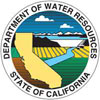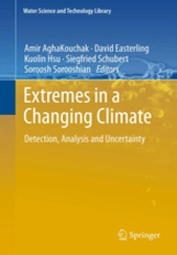
Extremes in a Changing Climate
Editors: AghaKouchak A., Easterling D., Hsu K., Schubert S., Sorooshian S.

Remote Sensing of Drought
Editors: Anderson M., Wardlow B., Verdin J.
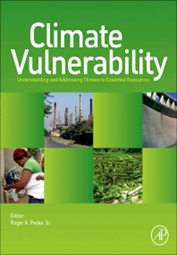
Climate Vulnerability
Editor in Chief: R Pielke, Sr.
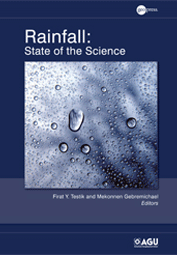
Rainfall: State of the Science
Editors: Testik F.Y. and Gebremichael M.
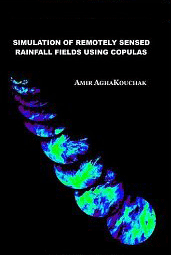
Simulation of Remotely Sensed Rainfall Fields Using Copulas
EAuthor: Amir AghaKouchak
Peer-Reviewed Journal Publications
58. AghaKouchak A., Feldman D., Hoerling M., Huxman T., Lund J., 2015, Recognize Anthropogenic Drought, Nature, 524 (7566), 409-4011, doi:10.1038/524409a. (pdf)
57. Mazdiyasni O., AghaKouchak A., 2015, Substantial Increase in Concurrent Droughts and Heatwaves in the United States, Proceedings of the National Academy of Sciences, doi: 10.1073/pnas.1422945112. (pdf)
56. AghaKouchak A., Farahmand A., Teixeira J., Wardlow B.D., Melton F.S., Anderson M.C., Hain C.R., 2015, Remote Sensing of Drought: Progress, Challenges and Opportunities, Reviews of Geophysics, 53 (2), 452-480, doi: 10.1002/2014RG000456. (pdf)
55. Vahedifard F., AghaKouchak A., Robinson J.D., 2015, Drought threatens California's levees, Science, 349 (6250), 799, doi: 10.1126/science.349.6250.799-a. (pdf)
54. Mehran A., Mazdiyasni O., AghaKouchak A., 2015, A Hybrid Framework for Assessing Socioeconomic Drought: Linking Climate Variability, Local Resilience, and Demand, Journal of Geophysical Research, 120 (15), 7520-7533, doi: 10.1002/2015JD023147. (pdf)
53. Shukla S., Safeeq M., AghaKouchak A., Guan K., Funk C., 2015, Temperature Impacts on the Water Year 2014 Drought in California, Geophysical Research Letters, 42, doi: 10.1002/2015GL063666. (pdf)
52. Askarizadeh A., Rippy M., Fletcher T., Feldman D., Peng J., Bowler P., Mehring A., Winfrey B., Vrugt J., AghaKouchak A., Jiang S., Sanders B., Levin L., Taylor S., Grant S., 2015, From rain tanks to catchments: Use of low-impact development to address hydrologic symptoms of the urban stream syndrome, Environmental Science & Technology, doi: 10.1021/acs.est.5b01635.
51. AghaKouchak A., Norouzi H., Madani K., Mirchi A., Azarderakhsh M., Nazemi N., Nasrollahi N., Mehran M., Farahmand A., Hasanzadeh E., 2015, Aral Sea Syndrome Desiccates Lake Urmia: Call for Action, Journal of Great Lakes Research, 41(1), 307-311, doi: 10.1016/j.jglr.2014.12.007. (pdf)
50. Cheng L., AghaKouchak A., Phillips T., 2015, Non-stationary Return Levels of CMIP5 Multi-Model Temperature Extremes, Climate Dynamics, 44(11), 2947-2963, doi: 10.1007/s00382-015-2625-y. (pdf)
49. Nasrollahi N., AghaKouchak A., Cheng L., Damberg L., Phillips T., Miao C., Hsu K., Sorooshian S., 2015, How Well Do CMIP5 Climate Simulations Replicate Historical Trends and Patterns of Meteorological Droughts?, Water Resources Research, 51(4), 2847-2864, doi: 10.1002/2014WR016318. (pdf)
48. Cheng L., AghaKouchak A., 2015, A Methodology for Deriving Ensemble Response from Multimodel Simulations, Journal of Hydrology, 522, 49-57, doi: 10.1016/j.jhydrol.2014.12.025. (pdf)
47. Farahmand A., AghaKouchak A., Teixeira J., 2015, A Vantage from Space Can Detect Earlier Drought Onset: An Approach Using Relative Humidity, Scientific Reports, 5, 8553; doi: 10.1038/srep08553. (pdf)
46. AghaKouchak A., 2015, A Multivariate Approach for Persistence-Based Drought Prediction: Application to the 2010-2011 East Africa Drought, Journal of Hydrology, 526, 127-135, doi: 10.1016/j.jhydrol.2014.09.063. (pdf)
45. Farahmand A., AghaKouchak A., 2015, A Generalized Framework for Deriving Nonparametric Standardized Drought Indicators, Advances in Water Resources, 76, 140-145, doi: 10.1016/j.advwatres.2014.11.012. (pdf)
44. Prakash S., Mitra A.K., AghaKouchak A., Pai D.S., 2015, Error characterization of TRMM Multisatellite Precipitation Analysis (TMPA-3B42) products over India for different seasons, Journal of Hydrology, in press.
43. Nguyen P., Thorstensen A., Sorooshian S., Hsu K., AghaKouchak A., 2015, Flood forecasting and inundation mapping using HiResFlood-UCI and near real-time satellite precipitation data: the 2008 Iowa flood, Journal of Hydrometeorology, 16(3), 1171-1183, doi: 10.1175/JHM-D-14-0212.1. (pdf)
42. Norouzi H., Temimi M., AghaKouchak A., Azarderakhsh M., Khanbilvardi R., Shields G., Tesfagiorgis K., 2015, Inferring Land Surface Parameters from the Diurnal Variability of Microwave and Infrared Temperatures, Physics and Chemistry of the Earth, doi: 10.1016/j.pce.2015.01.007. (pdf)
24. Golian S., Mazdiyasni O., AghaKouchak A., 2015, Trends in Meteorological and Agricultural Droughts in Iran, Theoretical and Applied Climatology, doi: 10.1007/s00704-014-1139-6.
Abstract:
The aim of this paper is to investigate characteristics of meteorological and agricultural droughts and their trends in Iran, as well as several sub-regions with different climate conditions from 1980 to 2013. The Standardized Precipitation Index (SPI) and Standardized Soil Moisture Index (SSI) are used as the primary indicators of meteorological and agricultural droughts, respectively. This study assesses historical droughts using the Multivariate Standardized Drought Index (MSDI) which provides a composite model of meteorological-agricultural drought. Furthermore, this study discusses the behavior of MSDI, relative to the other indices (SPI and SSI) over different climatic conditions ranging from humid, semi-arid, and hyper-arid regions. The Mann-Kendall trend test shows that the northern, northwestern and central parts of Iran have experienced significant drying trends at a 95% confidence level. However, there is no statistically significant drying trend in the eastern part of Iran. The most severe drought across the country occurred between 1998 and 2001, with nearly 80% of the country experiencing an Exceptional Drought (less than 2% probability of occurrence). This event coincided with a prolonged cold phase El Nino-Southern Oscillation (La Nina) that led to persistently cold sea surface temperatures in the eastern Pacific and warm sea surface temperatures in the Indian and western Pacific.
40. Li J., Hsu K., AghaKouchak A., Sorooshian S., 2015, An Object-based Approach for Verification of Precipitation Estimation, International Journal of Remote Sensing, doi: 10.1080/01431161.2014.999170. (pdf)
39. AghaKouchak A., Cheng L., Mazdiyasni O., Farahmand A., 2014, Global Warming and Changes in Risk of Concurrent Climate Extremes: Insights from the 2014 California Drought, Geophysical Research Letters, 41, 8847-8852, doi: 10.1002/2014GL062308. (pdf)
38. AghaKouchak A., Feldman D., Stewardson M.J., Saphores J.-D., Grant S., Sanders B., 2014, Australia's Drought: Lessons for California, Science, 343 (6178), 1430-1431, doi:10.1126/science.343.6178.1430. (pdf)
Abstract:
Most of California is suffering from an extreme drought, and storage levels in the major reservoirs are well below historic levels. For the past several months, an unusually stubborn ridge of high pressure off the West Coast of the United States has been blocking normal winter storms and the rain they carry. California's history of drought has led to statewide strategies to save water, but Californian residents and policy-makers can do even more: They can look to the story of Australia's experience with a drought so intense and long-lasting that it was dramatically dubbed the Millennium Drought
37. Cheng L., AghaKouchak A., 2014, Precipitation Intensity-Duration-Frequency Curves for Infrastructure Design in a Changing Climate, Scientific Reports, 4, 7093, doi: 10.1038/srep07093. (pdf)
36. AghaKouchak A., 2014, Entropy-Copula in Hydrology and Climatology, Journal of Hydrometeorology, 15(6), 2176-2189, doi: 10.1175/JHM-D-13-0207.1. (pdf)
35. Cheng L., AghaKouchak A., Gilleland E., Katz R.W., 2014, Non-stationary Extreme Value Analysis in a Changing Climate, Climatic Change, 127(2), 353-369, doi: 10.1007/s10584-014-1254-5. (pdf)
34. Hao Z., AghaKouchak A., Nakhjiri N., Farahmand A., 2014, Global Integrated Drought Monitoring and Prediction System, Scientific Data, 1:140001, 1-10, doi: 10.1038/sdata.2014.1. (pdf)
Abstract:
Drought is by far the most costly natural disaster that can lead to widespread impacts, including water and food crises. Here we present data sets available from the Global integrated drought monitoring and prediction system (GIDMaPS), which provides drought information based on multiple drought indicators. The system provides meteorological and agricultural drought information based on multiple satellite-, and model-based precipitation and soil moisture data sets. GIDMaPS includes a near real-time monitoring component and a seasonal probabilistic prediction module. The data sets include historical drought severity data from the monitoring component, and probabilistic seasonal forecasts from the prediction module. The probabilistic forecasts provide essential information for early warning, taking preventive measures, and planning mitigation strategies. GIDMaPS data sets are a significant extension to current capabilities and data sets for global drought assessment and early warning. The presented data sets would be instrumental in reducing drought impacts especially in developing countries. Our results indicate that GIDMaPS data sets reliably captured several major droughts from across the globe.
33. Cheng L., Gilleland E., Heaton M.J., AghaKouchak A., 2014, Empirical Bayes estimation for the conditional extreme value model, Stat, 3, 391-406, doi: 10.1002/sta4.71. (pdf)
32. Mehran A., AghaKouchak A., Phillips T.J., 2014, Evaluation of CMIP5 Continental Precipitation Simulations Relative to Satellite-Based Gauge-Adjusted Observations, Journal of Geophysical Research, 119, 1-13, doi: 10.1002/2013JD021152. (pdf)
Abstract:
The objective of this study is to cross-validate 34 Coupled Model Intercomparison Project Phase 5 (CMIP5) historical simulations of precipitation against the Global Precipitation Climatology Project (GPCP) data, quantifying model pattern discrepancies, and biases for both entire distributions and their upper tails. The results of the volumetric hit index (VHI) analysis of the total monthly precipitation amounts show that most CMIP5 simulations are in good agreement with GPCP patterns in many areas but that their replication of observed precipitation over arid regions and certain subcontinental regions (e.g., northern Eurasia, eastern Russia, and central Australia) is problematical. Overall, the VHI of the multimodel ensemble mean and median also are superior to that of the individual CMIP5 models. However, at high quantiles of reference data (75th and 90th percentiles), all climate models display low skill in simulating precipitation, except over North America, the Amazon, and Central Africa. Analyses of total bias (B) in CMIP5 simulations reveal that most models overestimate precipitation over regions of complex topography (e.g., western North and South America and southern Africa and Asia), while underestimating it over arid regions. Also, while most climate model simulations show low biases over Europe, intermodel variations in bias over Australia and Amazonia are considerable. The quantile bias analyses indicate that CMIP5 simulations are even more biased at high quantiles of precipitation. It is found that a simple mean field bias removal improves the overall B and VHI values but does not make a significant improvement at high quantiles of precipitation.
31. Song X., Zhang J., AghaKouchak A., Sen Roy S., Xuan Y., Wang G., He R., Wang X., Liu C., 2014, Rapid urbanization and changes in spatiotemporal characteristics of precipitation in Beijing metropolitan area, Journal of Geophysical Research, 119(19), 11250-11271, doi: 10.1002/2014JD022084. (pdf)
Abstract:
This study investigates changes in temporal trends and spatial patterns of precipitation in Beijing over the last six decades. These changes are discussed in the context of rapid urbanization and the growing imbalance between water supply and demand in Beijing. We observed significant decreases in precipitation amounts from 1950 to 2012, with the annual precipitation decreasing by 32% at a decadal rate of 28.5?mm. In particular, precipitation decrease is more pronounced in the summer and warm seasons when water use is at its seasonal peak. We further analyzed hourly precipitation data from 43 rain gauges between 1980 and 2012 to examine the spatiotemporal characteristics of both precipitation amount and intensity across six distinct subregions in Beijing. No significant spatial variations in precipitation changes were identified, but slightly greater amounts of precipitation were noted in the urban areas (plains) than in the surrounding suburbs (mountains), due to the effect of urbanization and topography. Precipitation intensity has increased substantially, especially at the hourly duration, as evidenced by the more frequent occurrence of extreme storms. The observed decreased water availability and the increase in extreme weather events require more integrated water management, particularly given the expectation of a warmer and more variable climate, the continued rapid growth of the Beijing metropolis, and the intensifying conflict between water supply and demand.
30. Sorooshian S., AghaKouchak A., Li J., 2014, Influence of Irrigation on Land Hydrological Processes over California, Journal of Geophysical Research, 119(23), 13137-13152, doi: 10.1002/2014JD022232. (pdf)
Abstract:
In this study, a regional climate model (RCM) is employed to investigate the effect of irrigation on hydrology over California through implementing a �realistic irrigation� scheme. Our results indicate that the RCM with a realistic irrigation scheme commonly practiced in California can capture the soil moisture and evapotranspiration (ET) variation very well in comparison with the available in situ and remote sensing data. The RCM results show significant improvement in comparison with those outputs from the default run and the commonly used runs with fixed soil moisture at field capacity. Furthermore, the model reproduces the observed decreasing trends of the reference ET (i.e., ET0) from the California Irrigation Management Information System (CIMIS). The observed decreasing trend is most likely due to the decreasing trend of downward solar radiation shown by models and CIMIS observations. This issue is fundamental in projecting future irrigation water demand. The deep soil percolation rate changes depending on the irrigation method and irrigation duration. Finally, the model results show that precipitation change due to irrigation in California is relatively small in amount and mainly occurs along the midlatitudes in the western United States.
29. Tabari H., AghaKouchak A., Willems P., 2014, A perturbation approach for assessing trends in precipitation extremes across Iran, Journal of Hydrology, 519, 1420-1427, doi: 10.1016/j.jhydrol.2014.09.019. (pdf)
Abstract:
Extreme precipitation events have attracted a great deal of attention among the scientific community because of their devastating consequences on human livelihood and socio-economic development. To assess changes in precipitation extremes in a given region, it is essential to analyze decadal oscillations in precipitation extremes. This study examines temporal oscillations in precipitation data in several sub-regions of Iran using a novel quantile perturbation method during 1980�2010. Precipitation data from NASA�s Modern-Era Retrospective Analysis for Research and Applications-Land (MERRA-Land) are used in this study. The results indicate significant anomalies in precipitation extremes in the northwest and southeast regions of Iran. Analysis of extreme precipitation perturbations reveals that perturbations for the monthly aggregation level are generally lower than the annual perturbations. Furthermore, high-oscillation and low-oscillation periods are found in extreme precipitation quantiles across different seasons. In all selected regions, a significant anomaly (i.e., extreme wet/dry conditions) in precipitation extremes is observed during spring.
28. Tarroja B., AghaKouchak A., Samuelsen S., Sobhani R., Feldman D., Jiang S., 2014, Evaluating Options for Balancing the Water-Electricity Nexus in California: Part 1 - Securing Water Availability, Science of the Total Environment, 497-498, 697-710, doi: 10.1016/j.scitotenv.2014.06.060. (pdf)
Abstract:
The technical potential and effectiveness of different water supply options for securing water availability in a large-scale, interconnected water supply system under historical and climate-change augmented inflow and demand conditions were compared. Part 1 of the study focused on determining the scale of the options required to secure water availability and compared the effectiveness of different options. A spatially and temporally resolved model of California's major surface reservoirs was developed, and its sensitivity to urban water conservation, desalination, and water reuse was examined. Potential capacities of the different options were determined. Under historical (baseline) hydrology conditions, many individual options were found to be capable of securing water availability alone. Under climate change augment conditions, a portfolio approach was necessary. The water savings from many individual options other than desalination were insufficient in the latter, however, relying on seawater desalination alone requires extreme capacity installations which have energy, brine disposal, management, and cost implications. The importance of identifying and utilizing points of leverage in the system for choosing where to deploy different options is also demonstrated.
27. Tarroja B., AghaKouchak A., Samuelsen S., Sobhani R., Feldman D., Jiang S., 2014, Evaluating Options for Balancing the Water-Electricity Nexus in California: Part 2 - Greenhouse Gas and Renewable Energy Utilization Impacts, Science of the Total Environment, 497-498, 711-724, doi: 10.1016/j.scitotenv.2014.06.071. (pdf)
Abstract:
A study was conducted to compare the technical potential and effectiveness of different water supply options for securing water availability in a large-scale, interconnected water supply system under historical and climate-change augmented inflow and demand conditions. Part 2 of the study focused on determining the greenhouse gas and renewable energy utilization impacts of different pathways to stabilize major surface reservoir levels. Using a detailed electric grid model and taking into account impacts on the operation of the water supply infrastructure, the greenhouse gas emissions and effect on overall grid renewable penetration level was calculated for each water supply option portfolio that successfully secured water availability from Part 1. The effects on the energy signature of water supply infrastructure were found to be just as important as that of the fundamental processes for each option. Under historical (baseline) conditions, many option portfolios were capable of securing surface reservoir levels with a net neutral or negative effect on emissions and a benefit for renewable energy utilization. Under climate change augmented conditions, however, careful selection of the water supply option portfolio was required to prevent imposing major emissions increases for the system. Overall, this analysis provided quantitative insight into the tradeoffs associated with choosing different pathways for securing California's water supply.
26. AghaKouchak A., 2014, A Baseline Probabilistic Drought Forecasting Framework Using Standardized Soil Moisture Index: Application to the 2012 United States Drought, Hydrology and Earth System Sciences, 18, 2485-2492, doi: 10.5194/hess-18-2485-2014. (pdf)
Abstract:
The 2012 drought was one of the most extensive drought events in half a century, resulting in over USD 12 billion in economic loss in the United States and substantial indirect impacts on global food security and commodity prices. An important feature of the 2012 drought was rapid development and intensification in late spring/early summer, a critical time for crop development and investment planning. Drought prediction remains a major challenge because dynamical precipitation forecasts are highly uncertain, and their prediction skill is low. Using a probabilistic framework for drought forecasting based on the persistence property of accumulated soil moisture, this paper shows that the US drought of summer 2012 was predictable several months in advance. The presented drought forecasting framework provides the probability occurrence of drought based on climatology and near-past observations of soil moisture. The results indicate that soil moisture exhibits higher persistence than precipitation, and hence improves drought predictability.
25. Momtaz F., Nakhjiri N., AghaKouchak A., 2014, Toward a Drought Cyberinfrastructure System, Eos, Transactions American Geophysical Union, 95(22), 182-183, doi:10.1002/2014EO220002. (pdf)
Abstract:
Drought chokes ecosystems, straggles economies, and threatens human health. The Global Integrated Drought Monitoring and Prediction System gathers and synthesizes land-atmosphere model simulations and remote sending observations to generate drought predictions. The system could help farmers, commodity investors, local governments, and global relief organizations plan for and react to droughts.
24. Hao Z., AghaKouchak A., 2013, A Nonparametric Multivariate Multi-Index Drought Monitoring Framework, Journal of Hydrometeorology, doi:10.1175/JHM-D-12-0160.1. (pdf)
Abstract:
Accurate and reliable drought monitoring is essential to drought mitigation efforts and reduction of social vulnerability. A variety of indices, such as the Standardized Precipitation Index (SPI), are used for drought monitoring based on different indicator variables. Due to the complexity of drought phenomena in their causation and impact, drought monitoring based on a single variable may be insufficient for detecting drought conditions in a prompt and reliable manner. This study outlines a multivariate, multi-index drought monitoring framework, namely the Multivariate Standardized Drought Index (MSDI), for describing droughts based on the states of precipitation and soil moisture. In this study, the MSDI is evaluated against U.S. Drought Monitor (USDM) data, as well as the commonly used standardized indices for drought monitoring, including detecting drought onset, persistence, and spatial extent across the continental United States. The results indicate that MSDI includes attractive properties, such as higher probability of drought detection, compared to individual precipitation and soil moisture based drought indices. This study shows that the MSDI leads to drought information generally consistent with the USDM, and provides additional information and insights into drought monitoring.
23. Liu Z., Mehran A., Phillips T.J., AghaKouchak A., 2014, Seasonal and Regional Biases in CMIP5 Precipitation Simulations, Climate Research, doi: 10.3354/cr01221.
Abstract:
This study provides insight into how CMIP5 climate models perform in simulating summer and winter precipitation, at different geographical locations and climate conditions. Precipitation biases in the CMIP5 historical (1901-2005) simulations relative to the Climatic Research Unit (CRU) observations are evaluated over 8 regions exhibiting distinct seasonal hydroclimates: moist tropical (Amazonia and central Africa); monsoonal (southern China); moist continental (central Europe); semi-arid (western United States and eastern Australia); and polar (Siberia and Canada). While the bias and monthly quantile bias (MQB, defined herein) reflect no substantial differences in CMIP5 summer and winter precipitation simulations at the global scale, strong seasonality and high inter-model variability are found over the selected moist tropical regions (i.e., Amazon and central Africa). In the semi-arid regions, high inter-model precipitation variability is also displayed, especially in summer, while the median of simulations is an overestimate of both winter and summer precipitation. In Siberia and central Europe, most CMIP5 models underestimate summer precipitation, and overestimate it in winter. Also, the MQB values decrease as the choice of quantile thresholds increase, implying that the underestimation of summer precipitation is primarily associated with biases in lower quantiles of the precipitation distribution. While the CMIP5 models exhibit similar behaviors in simulating high-latitude winter precipitation, they differ substantially in summer simulations for the selected Canadian and Siberian regions. Finally, in the monsoonal southern China region, CMIP5 models exhibit large overall precipitation biases in both summer and winter, as well as at higher quantiles.
22. Mehran A., AghaKouchak A., 2013, Capabilities of Satellite Precipitation datasets to Estimate Heavy Precipitation Rates at Different Temporal Accumulations, Hydrological Processes, doi: 10.1002/hyp.9779. (pdf)
Abstract:
The importance of satellite datasets as alternative sources of precipitation information has been argued in numerous studies. Future developments in satellite precipitation algorithms as well as utilization of satellite data in operational applications rely on a more in-depth understanding of satellite errors and biases across different spatial and temporal scales. This paper investigates the capability of satellite precipitation data sets with respect to detecting heavy precipitation rates over different temporal accumulations. In this study, the performance of Tropical Rainfall Measuring Mission real time (TRMM-RT), Precipitation Estimation from Remotely Sensed Information using Artificial Neural Networks and CPC MORPHing (CMORPH) is compared against radar-based gauge-adjusted Stage IV data. The results show that none of the high temporal resolution (3-h) datasets are ideal for detecting heavy precipitation rates. In fact, the detection skill of all products drops as the precipitation thresholds (i.e. 75 and 90 percentiles) increase. At higher temporal accumulations (6, 12 and 24 h), the detection skill improves for all precipitation products, with CMORPH showing a better detection skill compared to all other products. On the other hand, all precipitation products exhibit high false alarm ratios above the heavy precipitation thresholds, although TRMM-RT lead to a relatively smaller level of false alarms. These results indicate that further efforts are necessary to improve the precipitation algorithms so that they can capture heavy precipitation rates more reliably.
21. Damberg L., AghaKouchak A., 2013, Global Trends and Patterns of Droughts from Space, Theoretical and Applied Climatology, doi: 10.1007/s00704-013-1019-5. (pdf)
Abstract:
This paper analyzes changes in areas under droughts over the past three decades and alters our understanding of how amplitude and frequency of droughts differ in the Southern Hemisphere (SH) and Northern Hemisphere (NH). Unlike most previous global-scale studies that have been based on climate models, this study is based on satellite gauge-adjusted precipitation observations. Here, we show that droughts in terms of both amplitude and frequency are more variable over land in the SH than in the NH. The results reveal no significant trend in the areas under drought over land in the past three decades. However, after investigating land in the NH and the SH separately, the results exhibit a significant positive trend in the area under drought over land in the SH, while no significant trend is observed over land in the NH. We investigate the spatial patterns of the wetness and dryness over the past three decades, and we show that several regions, such as the southwestern United States, Texas, parts of the Amazon, the Horn of Africa, northern India, and parts of the Mediterranean region, exhibit a significant drying trend. The global trend maps indicate that central Africa, parts of southwest Asia (e.g., Thailand, Taiwan), Central America, northern Australia, and parts of eastern Europe show a wetting trend during the same time span. The results of this satellite-based study disagree with several model-based studies which indicate that droughts have been increasing over land. On the other hand, our findings concur with some of the observation-based studies.
20. AghaKouchak A., Mehran A., 2013, Extended Contingency Table: Performance Metrics for Satellite Observations and Model Simulations, Water Resources Research, doi:10.1002/wrcr.20498. (pdf)
Abstract:
Validation of gridded satellite observations and climate model simulations are fundamental to future improvements in retrieval algorithms and model developments. Among the metrics, the contingency table, which includes a number of categorical indices, is extensively used in evaluation studies. While the categorical indices offer invaluable information, they do not provide any insight into the volume of the variable detected correctly/incorrectly. In this study, the contingency table categorical metrics are extended to volumetric indices for evaluation of gridded data. The suggested indices include (a) Volumetric Hit Index (VHI): volume of correctly detected simulations relative to the volume of the correctly detected simulations and missed observations; (b) Volumetric False Alarm Ratio (VFAR): volume of false simulations relative to the sum of simulations; (c) Volumetric Miss Index (VMI): volume of missed observations relative to the sum of missed observations and correctly detected simulations; and (d) the Volumetric Critical Success Index (VCSI). The latter provides an overall measure of volumetric performance including volumetric hits, false alarms, and misses. First, using two synthetic time series, the volumetric indices are evaluated against the contingency table categorical metrics. Then, the volumetric indices are used to evaluate a gridded data set at the continental scale. The results show that the volumetric indices provide additional information beyond the commonly used categorical metrics that can be useful in evaluating gridded data sets.
19. Hao Z., AghaKouchak A., Phillips T.J., 2013, Changes in Concurrent Monthly Precipitation and Temperature Extremes, Environmental Research Letters, 8(4), 034014 doi:10.1088/1748-9326/8/3/034014. (pdf)
Abstract:
While numerous studies have addressed changes in climate extremes, analyses of concurrence of climate extremes are scarce, and climate change effects on joint extremes are rarely considered. This study assesses the occurrence of joint (concurrent) monthly continental precipitation and temperature extremes in Climate Research Unit (CRU) and University of Delaware (UD) observations, and in 13 Coupled Model Intercomparison Project Phase 5 (CMIP5) global climate simulations. The joint occurrences of precipitation and temperature extremes simulated by CMIP5 climate models are compared with those derived from the CRU and UD observations for warm/wet, warm/dry, cold/wet, and cold/dry combinations of joint extremes. The number of occurrences of these four combinations during the second half of the 20th century (1951-2004) is assessed on a common global grid. CRU and UD observations show substantial increases in the occurrence of joint warm/dry and warm/wet combinations for the period 1978�2004 relative to 1951-1977. The results show that with respect to the sign of change in the concurrent extremes, the CMIP5 climate model simulations are in reasonable overall agreement with observations. However, the results reveal notable discrepancies between regional patterns and the magnitude of change in individual climate model simulations relative to the observations of precipitation and temperature.
18. Farahmand A., AghaKouchak A., 2013, A Satellite-Based Global Landslide Model, Natural Hazards and Earth System Sciences, in press.
Abstract:
Landslides are devastating phenomena that cause huge damages around the world. This paper presents a quasi-global landslide model derived using satellite precipitation data, land-use land cover maps, and 250 m topography information. This suggested landslide model is based on the Support Vector Machines (SVM), a machine learning algorithm. The National Aeronautics and Space Administration (NASA) Goddard Space Flight Center (GSFC) landslide inventory data is used as observations and reference data. 70% of the data are used for model development and training, whereas 30% are used for validation and verification. The results of 100 random sub-samples of available landslide observations revealed that the suggested landslide model can predict historical landslides reliably. The average error of 100 iterations of landslide prediction is estimated approximately 7%, while approximately 2% false landslide events are observed.
17. Hao Z., AghaKouchak A., 2013, Multivariate Standardized Drought Index: A Parametric Multi-Index Model, Advances in Water Resources, 57, 12-18, doi: 10.1016/j.advwatres.2013.03.009. (pdf)
Abstract:
Defining droughts based on a single variable/index (e.g., precipitation, soil moisture, or runoff) may not be sufficient for reliable risk assessment and decision-making. In this paper, a multivariate, multi-index drought-modeling approach is proposed using the concept of copulas. The proposed model, named Multivariate Standardized Drought Index (MSDI), probabilistically combines the Standardized Precipitation Index (SPI) and the Standardized Soil Moisture Index (SSI) for drought characterization. In other words, MSDI incorporates the meteorological and agricultural drought conditions for overall characterization of drought. In this study, the proposed MSDI is utilized to characterize the drought conditions over several Climate Divisions in California and North Carolina. The MSDI-based drought analyses are then compared with SPI and SSI. The results reveal that MSDI indicates the drought onset and termination based on the combination of SPI and SSI, with onset being dominated by SPI and drought persistence being more similar to SSI behavior. Overall, the proposed MSDI is shown to be a reasonable model for combining multiple indices probabilistically.
16. AghaKouchak A., Nakhjiri N., and Habib E., 2013, An educational model for ensemble streamflow simulation and uncertainty analysis, Hydrology and Earth System Sciences, 17, 445-452, doi:10.5194/hess-17-445-2013. (pdf)
Abstract:
This paper presents the hands-on modeling toolbox, HBV-Ensemble, designed as a complement to theoretical hydrology lectures, to teach hydrological processes and their uncertainties. The HBV-Ensemble can be used for in-class lab practices and homework assignments, and assessment of students' understanding of hydrological processes. Using this modeling toolbox, students can gain more insights into how hydrological processes (e.g., precipitation, snowmelt and snow accumulation, soil moisture, evapotranspiration and runoff generation) are interconnected. The educational toolbox includes a MATLAB Graphical User Interface (GUI) and an ensemble simulation scheme that can be used for teaching uncertainty analysis, parameter estimation, ensemble simulation and model sensitivity. HBV-Ensemble was administered in a class for both in-class instruction and a final project, and students submitted their feedback about the toolbox. The results indicate that this educational software had a positive impact on students understanding and knowledge of uncertainty in hydrological modeling.
15. AghaKouchak A., and Nakhjiri N., 2012, A Near Real-Time Satellite-Based Global Drought Climate Data Record, Environmental Research Letters, 7(4), 044037, doi:10.1088/1748-9326/7/4/044037 (pdf)
Abstract:
Reliable drought monitoring requires long-term and continuous precipitation data. High resolution satellite measurements provide valuable precipitation information on a quasi-global scale. However, their short lengths of records limit their applications in drought monitoring. In addition to this limitation, long-term low resolution satellite-based gauge-adjusted data sets such as the Global Precipitation Climatology Project (GPCP) one are not available in near real-time form for timely drought monitoring. This study bridges the gap between low resolution long-term satellite gauge-adjusted data and the emerging high resolution satellite precipitation data sets to create a long-term climate data record of droughts. To accomplish this, a Bayesian correction algorithm is used to combine GPCP data with real-time satellite precipitation data sets for drought monitoring and analysis. The results showed that the combined data sets after the Bayesian correction were a significant improvement compared to the uncorrected data. Furthermore, several recent major droughts such as the 2011 Texas, 2010 Amazon and 2010 Horn of Africa droughts were detected in the combined real-time and long-term satellite observations. This highlights the potential application of satellite precipitation data for regional to global drought monitoring. The final product is a real-time data-driven satellite-based standardized precipitation index that can be used for drought monitoring especially over remote and/or ungauged regions.
14. AghaKouchak A., Mehran A., Norouzi H., Behrangi A., 2012, Systematic and Random Error Components in Satellite Precipitation Data Sets, Geophysical Research Letters, L09406, 39, doi:10.1029/2012GL051592. (pdf)
Abstract:
This study contributes to characterization of satellite precipitation error which is fundamental to develop uncertainty models and bias reduction algorithms. Systematic and random error components of several satellite precipitation products are investigated over different seasons, thresholds and temporal accumulations. The analyses show that the spatial distribution of systematic error has similar patterns for all precipitation products. However, the systematic (random) error of daily accumulations is significantly less (more) than that of high resolution 3-hr data. One should note that the systematic biases of satellite precipitation are distinctively different in the summer and winter. The systematic (random) error is remarkably higher (lower) during the winter. Furthermore, the systematic error seems to be proportional to the rain rate magnitude. The findings of this study highlight that bias removal methods should take into account the spatiotemporal characteristics of error as well as the proportionality of error to the magnitude of rain rate.
13. Nasrollahi A., AghaKouchak A., Li J., Gao X., Sorooshian S., 2012, Assessing the impacts of different WRF precipitation physics in hurricane forecasts, Weather and Forecasting, doi:10.1175/WAF-D-10-05000.1. (pdf)
Abstract:
The socio-economic impact of reliable weather forecasting is well recognized, particularly in disaster management and decision making. Numerical weather prediction models play a major role in weather forecasting, especially in cases of extreme events. The Weather Research and Forecasting (WRF) model, among others, is extensively used for both research and practical applications. Previous studies have highlighted the sensitivity of this model to microphysics and cumulus schemes. This study investigated the performance of the WRF model in forecasting precipitation, hurricane track, and landfall time using various microphysics and cumulus schemes. A total of 20 combinations of microphysics and cumulus schemes were used and the model outputs were validated against ground-based observations. While the choice of microphysics and cumulus schemes can significantly impact model output, it is not the case that any single combination can be considered "ideal" for modeling all characteristics of a hurricane, including precipitation amount, areal extent, hurricane track, and the time of landfall. For example, the model's ability to simulate precipitation (with least total bias) is best achieved using Betts-Miller-Janjic (BMJ) cumulus parameterization in combination with the WSM5 microphysics option. it was determined that the WSM5-BMJ, WSM3-BMJ and Ferier microphysics in combination with Grell-Devenyi cumulus scheme were the best combinations for simulation of the landfall time. However, hurricane track was best estimated using the LIN and KES microphysics options with BMJ cumulus parameterization. Contrary to previous studies, these results indicated that the use of cumulus schemes improves model outputs when the grid size is smaller than 10 km. However, we found that many of the differences between parameterization schemes may be well within the uncertainty of the measurements.
12. AghaKouchak A., Nasrollahi N., Li J., Imam B., Sorooshian S., 2011, Geometrical Characterization of Precipitation Patterns, Journal of Hydrometeorology, 12 (2), 274-285, doi: 10.1175/2010JHM1298.1. (pdf)
Abstract:
Satellite estimates and weather forecast models have made it possible to observe and predict precipitation over large spatial scales. Despite substantial progress in observing patterns of precipitation, characterization of spatial patterns is still a challenge. Quantitative assessment methods for spatial patterns are essential for future developments in prediction of the spatial extent and patterns of precipitation. In this study, precipitation patterns are characterized using three geometrical indices: (a) A connectivity index; (b) a shape index; and (c) a dispersiveness index. Using multiple examples, the application of the proposed indices are explored in pattern analysis of satellite precipitation images, and validation of numerical atmospheric models with respect to geometrical properties. The results indicate that presented indices can be reasonably employed for relative comparison of different patterns (e.g., multiple fields against spatial observations) with respect to their connectivity, organization and shape.
11. Sorooshian S., AghaKouchak A., Arkin P., Eylander J., Foufoula-Georgiou E., Harmon R., Hendrickx J., Imam B., Kuligowski R., Skahill B., Skofronick-Jackson G., 2011, Advanced Concepts on Remote Sensing of Precipitation at Multiple Scales, Bulletin of the American Meteorological Society, doi: 10.1175/2011BAMS3158.1. (pdf)
Abstract:
This article summarizes the research priorities and discussions emerged from the Advanced Concepts Workshop on Remote Sensing of Precipitation at Multiple Scales, held at the University of California Irvine, March 15-17, 2010. The main objective was to develop a list of research recommendations in the field of remote sensing of precipitation. Research challenges and advanced concepts in satellite-retrieved precipitation estimation were explored in three main themes: (I) Precipitation Measurements and Algorithms; (II) Modeling and Uncertainties; and (III) Applications.
10. AghaKouchak A., Behrangi A., Sorooshian S., Hsu K., Amitai E., 2011, Evaluation of satellite-retrieved extreme precipitation rates across the Central United States, Journal of Geophysical Research, 116, D02115, doi:10.1029/2010JD014741. (pdf)
Abstract:
Water resources management, forecasting and decision making require reliable estimates of precipitation. Extreme precipitation events are of particular importance due to their severe impact on the economy, the environment and the society. In recent years, the emergence of various satellite-retrieved precipitation products with high spatial resolutions and global coverage have resulted in new sources of uninterrupted precipitation estimates. However, satellite-based estimates are not well integrated into operational and decision making applications due to lack of information on the associated uncertainties and reliability of these products. In this study, four satellite-derived precipitation products (CMORPH, PERSIANN, TMPA-RT and TMPA-V6) are evaluated with respect to their performance in capturing precipitation extremes. The STIV (radar-based gauge-adjusted) precipitation estimates are used as reference data. The results show that with respect to the probability of detecting extremes and the volume of correctly identi.ed precipitation, CMORPH and PERSIANN datasets lead to better estimates. However, their false alarm ratio and volume are higher than those of TMPA-RT and TMPA-V6. Overall, no single precipitation product can be considered as ideal for detecting extreme events. In fact, all precipitation products, tend to miss a signi.cant volume of rainfall. With respect to veri.cation metrics, used in this study, the performance of all satellite products tended to worsen as the choice of extreme precipitation threshold increased. The analyses suggest that extensive e.orts are necessary to develop algorithms that can capture extremes more reliably.
9. Behrangi A., Khakbaz B., Jaw T.C., AghaKouchak A., Hsu K., Sorooshian S., 2011, Hydrologic evaluation of satellite precipitation products over a mid-size basin, Journal of Hydrology, 397, 225-237, doi: 10.1016/j.jhydrol.2010.11.043. (pdf)
Abstract:
Over the past three decades, a great deal of effort has been devoted to the development of satellite-based precipitation retrieval algorithms. More recently, several satellite-based precipitation products have emerged as uninterrupted with quasi-global coverage. These satellite-based precipitation products provide an unprecedented opportunity for hydrometeorological applications and climate studies. Although growing, the application of satellite data for hydrological applications is still very limited. In this study, the effectiveness of using satellite-based precipitation products for streamflow simulation at catchment scale is evaluated. Five satellite-based precipitation products (TMPA-RT, TMPA-V6, CMORPH, PERSIANN, and PERSIANN-adj) are used as forcing 21 data for streamflow simulations at 6 hour and monthly time scales during the period of 2003-2008. The SACramento Soil Moisture Accounting (SAC-SMA) model is used for streamflow simulation. The results show that, by employing the satellite-based precipitation forcing, the general streamflow patterns are well captured at both 6-hour and monthly time scales. However, satellites products, with no bias adjustment being employed, significantly overestimate both precipitation inputs and simulated streamflows over warm months (spring and summer months). For the cold season, on the other hand, the unadjusted precipitation products result in underestimation of streamflow forecasts. It was found that bias-adjustment of precipitation is critical and can yield substantial improvement in capturing both streamflow pattern and magnitude. The results suggest that, along with efforts to improve satellite-based precipitation estimation techniques, it is important to develop more effective, near real-time precipitation bias-adjustment techniques for hydrologic applications.
8. AghaKouchak A., Habib E., Bardossy A., 2010, A Comparison of Three Remotely Sensed Rainfall Ensemble Generators, Atmospheric Research, 98(2-4), 387-399, doi: 10.1016/j.atmosres.2010.07.016. (pdf)
Abstract:
In this paper three different stochastic ensemble generators are assessed based on their performance in ensemble generation of hourly and 15-min radar-based rainfall fields. The simulation methods include a Gaussian copula model, a t-copula based approach and a non-Gaussian v-copula model. In the first and second models, two different elliptical copulas are employed to describe the dependence structures and to simulate multivariate rainfall error fields. In the third approach, a non-Gaussian v-transformed copula is applied for multivariate error simulations. Using this type of copula, one can describe asymmetrical dependencies through the copula parameters. In all three models, the outputs of the error simulators are used to perturb radar-based rainfall estimates to obtain an ensemble of precipitation estimates. In order to examine reliability and performance of the presented models, several case studies are performed using radar reflectivity data (Level II) and Stage IV NEXRAD multi-sensor precipitation estimates as input to the models. Various statistical tests are employed to assess the models. The results indicate that the presented models are rather similar with respect to the dependence structure. However, using the t-copula model may have significant advantages over the other models, particularly, with respect to extremes. While all the presented models are able to simulate reasonable rainfall ensembles, the t-copula model seems to be more promising for practical applications.
7. AghaKouchak A., Ciach G., Habib E., 2010, Estimation of Tail Dependence Coefficient in Rainfall Accumulation Fields, Advances in Water Resources, 33(9), 1142-1149, doi: 10.1016/j.advwatres.2010.07.003. (pdf)
Abstract:
Extreme rainfall events are of particular importance due to their severe impact on the economy, the environment and the society. The ongoing global climate change stimulates growing demand for new measurement techniques and analysis methods of the precipitation processes. An important concept in statistical modeling is the tail dependence coefficient (TDC) that describes the degree of association between concurrent rainfall extremes at different locations. Accurate knowledge of the spatial characteristics of the TDC can help improve on the existing models of the occurrence probability of extreme storms. In this study, efficient estimation of the TDC in rainfall is investigated using a dense network of rain gauges located in south Louisiana, USA. The inter-gauge distances in this network range from about 1 km to 9 km. Four different nonparametric TDC estimators are implemented on samples of the rain gauge data and their advantages and disadvantages are discussed. Three averaging time-scales are considered: 1-hr, 2-hr and 3-hr. The results indicate that a significant tail dependency may exist that cannot be ignored for realistic modeling of multivariate rainfall fields. Presence of a strong dependence among extremes contradicts with the assumption of joint normality, commonly used in hydrologic applications.
6. AghaKouchak A., Bardossy A., Habib E., 2010, Conditional Simulation of Remotely Sensed Rainfall Fields Using a Non-Gaussian V-Transformed Copula, Advances in Water resources, 33 (6), 624-634, doi:10.1016/j.advwatres.2010.02.010. (pdf)
Abstract:
Quantification of rainfall and its spatial and temporal variability is extremely important for reliable hydrological and meteorological modeling. While rain gauge measurements do not provide reasonable areal representation of rainfall, remotely sensed precipitation estimates offer much higher spatial resolution. However, uncertainties associated with remotely sensed rainfall estimates are not well quantified. This issue is important considering the fact that uncertainties in input rainfall are the main sources of error in hydrologic processes. Using an ensemble of rainfall estimates that resembles multiple realizations of possible true rainfall, one can assess uncertainties associated with remotely sensed rainfall data. In this paper, ensembles are generated by imposing rainfall error fields over remotely sensed rainfall estimates. A non-Gaussian copula-based model is introduced for simulation of rainfall error fields. The v-transformed copula is employed to describe the dependence structure of rainfall error estimates without the inuence of the marginal distribution. Simulations using this model can be performed unconditionally or conditioned on ground reference measurements such that rain gauge data are honored at their locations. The presented model is implemented for simulation of rainfall ensembles across the Little Washita watershed, Oklahoma. The results indicate that the model generates rainfall fields with similar spatio-temporal characteristics and stochastic properties to those of observed rainfall data.
5. AghaKouchak A., Bardossy A., Habib E., 2010, Copula-Based Uncertainty Modeling: Application to Multi-sensor Precipitation Estimates, Hydrological Processes, 24 (15), 2111-2124, doi: 10.1002/hyp.7632. (pdf)
Abstract:
The multi-sensor precipitation estimates (MPE) data, available in hourly temporal and 4 km x 4 km spatial resolution, are produced by the National Weather Service and mosaicked as a national product known as Stage IV. The MPE products have a significant advantage over rain gauge measurements due to their ability to capture spatial variability of rainfall. However, the advantages are limited by complications related to the indirect nature of remotely sensed precipitation estimates. Previous studies confirm that efforts are required to determine the accuracy of MPE and their associated uncertainties for future use in hydrological and climate studies. So far, various approaches and extensive research have been undertaken to develop an uncertainty model. In this paper an ensemble generator is presented for MPE products that can be used to evaluate the uncertainty of rainfall estimates. Two different elliptical copula families namely Gaussian and t-copula are employed for simulations. The results indicate that using t-copula may have significant advantages over the well known Gaussian copula particularly with respect to extremes. Overall the model in which t-copula was employed for simulation, successfully generated rainfall ensembles with similar characteristics to those of the ground reference measurements.
4. AghaKouchak A., Nasrollahi N., 2010, Semi-Parametric and Parametric Inference of Extreme Value Models for Rainfall Data, Water Resources Management, 24 (6), 1229-1249, doi: 10.1007/s11269-009-9493-3. (pdf)
Abstract:
Extreme rainfall events and the clustering of extreme values provide fundamental information which can be used for the risk assessment of extreme floods. Event probability can be estimated using the extreme value index which describes the behavior of the upper tail and measures the degree of extreme value clustering. In this paper, various semi-parametric and parametric extreme value index estimators are implemented in order to characterize the tail behavior of long-term daily rainfall time series. The results obtained from different estimators are then used to extrapolate the distribution function of extreme values. Extrapolation can be employed to estimate the occurrence probability of rainfall events above a given threshold. The results indicated that different estimators may result in considerable differences in extreme value index estimates. The uncertainty of the extreme value estimators is also investigated using the bootstrap technique. The analyses showed that the parametric methods are superior to the semi-parametric approaches. In particular, the likelihood and Two-Step estimators are preferred as they are found to be more robust and consistent for practical application.
3. AghaKouchak A., Habib E., Bardossy A., 2010, Modeling Radar Rainfall Estimation Uncertainties: Random Error Model, Journal of Hydrologic Engineering, 15(4), 265-274, doi:10.1061/(ASCE)HE.1943-5584.0000185. (pdf)
Abstract:
Precipitation is a major input in hydrological models. Radar rainfall data compared with rain gauge measurements provide higher spatial and temporal resolution. However, radar data obtained form reflectivity patterns are subject to various errors such as errors in reflectivity-rainfall (Z-R) relationships, variation in vertical profile of reflectivity, and spatial and temporal sampling among others. Characterization of such uncertainties in radar data and their effects on hydrologic simulations is a challenging issue. The superposition of random error of different sources is one of the main factors in uncertainty of radar estimates. One way to express these uncertainties is to stochastically generate random error fields and impose them on radar measurements in order to obtain an ensemble of radar rainfall estimates. In the present study, radar uncertainty is included in the Z-R relationship whereby radar estimates are perturbed with two error components: purely random error and an error component that is proportional to the magnitude of rainfall rates. Parameters of the model are estimated using the maximum likelihood method in order to account for heteroscedasticity in radar rainfall error estimates. An example implementation of this approached is presented to demonstrate the model performance. The results confirm that the model performs reasonably well in generating an ensemble of radar rainfall fields with similar stochastic characteristics and correlation structure to that of unperturbed radar estimates.
2. AghaKouchak A., Habib E., 2010, Application of a Conceptual Hydrologic Model in Teaching Hydrologic Processes, International Journal of Engineering Education, 26(4), 963-973. (pdf)
Abstract:
In this study, a hands-on modeling tool is developed for students in civil engineering and earth science disciplines to help them learn the fundamentals of hydrologic processes and basic concepts of model calibration and sensitivity analysis and practice conceptual thinking in solving and analysis of engineering problems. This modeling tool aims to provide an interdisciplinary application-oriented learning environment that introduces the hydrologic phenomena through the use of a simplified conceptual hydrologic model. The modeling tool was introduced in an upper-level civil engineering course and students were asked to submit their feedbacks before and after using the modeling tool through the Student Assessment of Learning Gains (SALG) online system to gauge improvement in their learning. The SALG report showed that the hands-on approach significantly added to students' learning and provided them with better understanding of inter-connected hydrologic processes. Furthermore, students gained knowledge in areas that are not commonly taught in hydrology lectures (e.g. calibration, sensitivity analysis, etc). Based on the findings, some recommendations are given for further improvements in the use of hydrologic models as interactive tools for teaching complex and inter-connected hydrologic concepts and inspiring students towards graduate higher education or future professional career.
1. AghaKouchak A., Nasrollahi N., Habib E., 2009, Accounting for Uncertainties of the TRMM Satellite Estimates, Remote Sensing, 1(3), 606-619, doi: 10.3390/rs1030606. (pdf)
Abstract:
Recent advances in the field of remote sensing have led to an increase in available rainfall data on a regional and global scale. Several NASA sponsored satellite missions provide valuable precipitation data. However, the advantages of the data are limited by complications related to the indirect nature of satellite estimates. This study intends to develop a stochastic model for uncertainty analysis of satellite rainfall fields through simulating error fields and imposing them over satellite estimates. In order to examine reliability and performance of the presented model, ensembles of satellite estimates are simulated for a large area across the North and South Carolina. The generated ensembles are then compared with original satellite estimates with respect to statistical properties and spatial dependencies. The results show that the model can be used to describe the uncertainties associated to TRMM multi-satellite precipitation estimates. The presented model is validated using random sub-samples of the observations based on the bootstrap technique. The results indicate that the model performs reasonably well with different numbers of available rain gauges.
Sponsors







